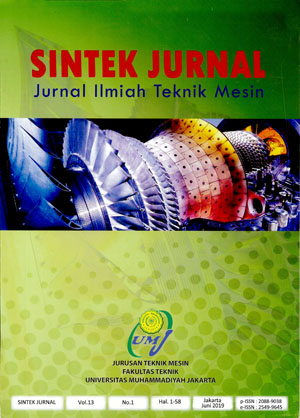TEKNOLOGI PROSES PENGECATAN MENGGUNAKAN SISTEM ATOMISASI PADA PRODUK BERBAHAN PLASTIK DI INDUSTRI PERAKITAN SEPEDAMOTOR
Main Article Content
Abstract
Article Details
- Articles published in SINTEK JURNAL are licensed under a Creative Commons Attribution-ShareAlike 4.0 International license. You are free to copy, transform, or redistribute articles for any lawful purpose in any medium, provided you give appropriate credit to the original author(s) and SINTEK JURNAL, link to the license, indicate if changes were made, and redistribute any derivative work under the same license.
- Copyright on articles is retained by the respective author(s), without restrictions. A non-exclusive license is granted to SINTEK JURNAL to publish the article and identify itself as its original publisher, along with the commercial right to include the article in a hardcopy issue for sale to libraries and individuals.
- By publishing in SINTEK JURNAL, authors grant any third party the right to use their article to the extent provided by the Creative Commons Attribution-ShareAlike 4.0 International license.
References
Artikel Kementrian Perindustrian, “Kementrian Perindustrian Republik indonesia,” 2012.
R. A. Nallicheri, “Automotive Painting : An Economic and Strategic Analysis,” Massachusetts Institute Of Technology, Cambridge, Massachusetts, 1994.
S. A. Colbert and R. A. Cairncross, “A computer simulation for predicting electrostatic spray coating patterns,” in Powder Technology, 2005.
R. Talbert, Paint Technology Handbook. 2010.
L. P. Bayvel and Z. Orzechowski, Liquid atomization. 1993.
K. D. Weiss, “Paint and coatings: A mature industry in transition,” Prog. Polym. Sci., 1997.
C. Schoff, “PaintingProblems,” in Coatings Of Polymers And Plastiks, 2003.
S. Spieckermann, K. Gutenschwager, and S. Voß, “A sequential ordering problem in automotive paint shops,” Int. J. Prod. Res., vol. 42, no. 9, pp. 1865–1878, 2004.
A. Goldschmidt and H. Joachim-streitberger, BASF Handbook on Basics of Coating Technology. Hannover, Germany, 2003.
I. Kolev, “Coatings on Plastiks — Technology Designed for a Wide Range of Solutions,” Soc. Vac. Coaters, 2013.
N. Dhafr, M. Ahmad, B. Burgess, and S. Canagassababady, “Improvement of quality performance in manufacturing organizations by minimization of production defects,” Robot. Comput. Integr. Manuf., 2006.
L. R. Botelho, J. C. Leite, and J. N. N. Quaresma, “Proposed solution for reduce defects in the process of paintingof plastik parts of motorcycle industry,” Espacios, 2017.
PT Astra Honda Motor, “Manufacturing Process PaintingPlastik,” Qual. Dep., 2000.
PT Murni Cahaya Pratama, “Modul Training Pengetahuan PaintingProses,” 2008.
B. A. Graves, “Paintingplastiks at Harley-Davidson,” Prod. Finish., 1996.
H. Janik, M. Sienkiewicz, and J. Kucinska-Lipka, “Polyurethanes,” in Handbook of Thermoset Plastiks, 2013.
A. H. Lefebvre and V. G. McDonell, Atomization and sprays. 2017.


